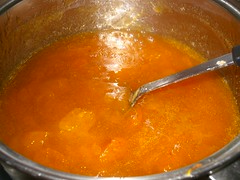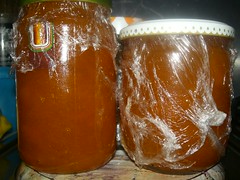A friend recently gave me some rather large firm oval-shaped plums, two large supermarket bags full of them. They were beautiful to look at from the outside, a deep reddish-purple colour, they almost looked like gems. But their yellow interior was rather dry and not so sweet. My friend had used them to make jam last year - this year, since she still had enough jam to tide her through the following year, she decided to make chutney.
Through the internet, I discovered that this fruit is known as the European plum, of the "Tulare giant" variety. They are not so tart and juicy, like regular plums. Since they would not be eaten, I wondered what to do with them - I couldn't just throw them away. If I pretended that they weren't even in my fridge, I would have allowed them to spoil naturally and then I would have a good excuse to throw them away. I set about making some jam with them.
Making jam is very simple, so I decided to use the simplest jam recipe that I could find on the web: 1kg of stoned plums to 1kg of sugar, with a little water to dilute the sugar and some lemon juice to make the jam set. I also used my own jam-making knowledge from past experiences:
Through the internet, I discovered that this fruit is known as the European plum, of the "Tulare giant" variety. They are not so tart and juicy, like regular plums. Since they would not be eaten, I wondered what to do with them - I couldn't just throw them away. If I pretended that they weren't even in my fridge, I would have allowed them to spoil naturally and then I would have a good excuse to throw them away. I set about making some jam with them.
Making jam is very simple, so I decided to use the simplest jam recipe that I could find on the web: 1kg of stoned plums to 1kg of sugar, with a little water to dilute the sugar and some lemon juice to make the jam set. I also used my own jam-making knowledge from past experiences:
- instead of using just the juice, I chopped up the lemon as finely as possible and added the whole thing, including the peel, to the jam
- I also added the large oval pips of all the plums I used (which I removed after the jam was cooked) - fruit pips contain a lot of pectin, which helps the jam to set
- I added a large dollop of a secret ingredient which gives a special taste to dark coloured jam (you can't use this for light coloured jams as it darkens them and they lose their aesthetic appeal): appelstroop, an apple syrup with a firm consistency (I used the Timson brand), which a Dutch friend presented to me as a gift.
I quartered the fruit to keep it as whole as possible, but if you prefer a less fruity look to your jam, you can chop the plums into smaller pieces.
 More preserved fruits - sour cherries, kumquat, biterr orange and unripe figs.
More preserved fruits - sour cherries, kumquat, biterr orange and unripe figs.
Bonus photo:
 More preserved fruits - sour cherries, kumquat, biterr orange and unripe figs.
More preserved fruits - sour cherries, kumquat, biterr orange and unripe figs.
©All Rights Reserved/Organically cooked. No part of this blog may be reproduced and/or copied by any means without prior consent from Maria Verivaki.







